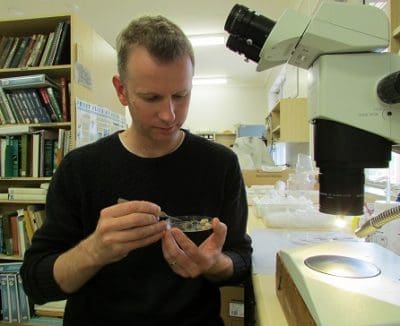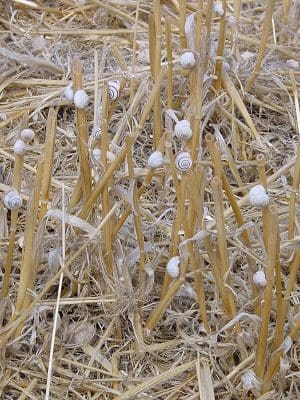A THREE-PRONGED action plan could be the best way to minimise the risk of snail contamination of grain this harvest.

SARDI entomologist Kym Perry says a number of tactics can be employed at harvest to reduce snail contamination.
Minimising the intake of snails into the header, maximising the separation of snails and grain within the header, and post-harvest grain cleaning are three important steps to reducing snail contamination.
South Australian Research and Development Institute (SARDI) entomologist, Kym Perry, said as crops matured, snails increasingly climbed plant stems in preparation for over-summering.
“Snails present above cutting height at harvest may enter the header and contaminate grain, potentially causing downgrades or rejection at receival, and they can also clog machinery,” Mr Perry said.
Mr Perry said while there was usually a trade-off between snail removal from grain and grain wastage, a number of tactics – under the three-pronged approach – could be employed at harvest to reduce contamination.
 “Growers should in the first instance assess the potential for snail contamination by monitoring around paddock perimeters and other areas where snails are often a problem. Snail densities provide a guide to contamination risk, though there is not always a clear relationship between live snail densities in paddocks and harvest contamination,” Mr Perry said.
“Growers should in the first instance assess the potential for snail contamination by monitoring around paddock perimeters and other areas where snails are often a problem. Snail densities provide a guide to contamination risk, though there is not always a clear relationship between live snail densities in paddocks and harvest contamination,” Mr Perry said.
Northern and Yorke Regional Landcare facilitator, Michael Richards, who has been leading an innovative project involving the establishment and monitoring of remote video cameras to record the movement and activity of round and conical snails at various locations across SA, agrees.
“Snail movement into crop canopies depends on complex interactions between weather conditions and snail behaviour,” Mr Richards said.
“In general, cool and moist conditions during harvest result in more snails remaining closer to ground level, while warm and drier conditions are more likely to increase snail densities in the upper canopy.”
He recommends growers prioritise harvesting the most valuable crops and those crops most prone to damage.
Other tactics growers can employ to minimise snail contamination include:
- Isolate areas of crop with higher snail densities, such as paddock perimeters. Harvest these crop areas early and store them separately for cleaning prior to delivery, to avoid mixing clean with contaminated grain.
- Organise access to a ‘snail crusher grain roller’ to treat contaminated grain prior to delivery. Post-harvest grain cleaning is the last opportunity for snail removal. Sometimes a combination of cleaning systems may be needed to meet receival standards without excessive grain losses. Rolling crushes snails in the grain and is effective for all hard grains at the optimal moisture content. The roller clearance needs to be adjusted to ensure snails are crushed while avoiding grain damage. Additional care needs to be taken with canola with fine tuning grain flow rates and roller clearances.
- Harvest using a stripper front where possible – this is one of the most effective methods for reducing snail contamination. Stripper fronts can significantly reduce snail intake in cereal crops relative to standard open front machines. They allow faster harvest speeds and will smash some snails as they enter the header. Raising the cutting height is a cheaper but less effective option.
- Windrowing (swathing) crops dislodges snails and assists with reducing snail contamination. This is most effective where crops are harvested soon after windrowing to reduce the opportunity for snails to reinvade the windrows.
- Use a dislodger bar attached to the header to knock snails from standing crops. This is most effective in removing larger snails in early-harvested or windrowed crops. The design should be adjusted for different crop types and conditions to maximise snail removal while minimising grain losses. Travelling at right angles to the direction of crop lean can further reduce losses.
- Set up sieves and mesh screens to maximise the separation of snails from grain within the header. Sheet metal (punch-hole and expanded mesh) sieves are generally more effective than louvre sieves in removing snails, but have a lower cleaning throughput. Therefore, harvest speed may need to be reduced to avoid overloading and grain losses. Where large numbers of snails are entering the harvester, a couple of loose chains securely attached to the top of the sieve can help prevent snails gumming up the sieve.
Receival standards for 2017-2018 currently range from 1-10 live or dead snails per 0.5 litre sample, depending on the commodity grade, and are available at http://www.graintrade.org.au/commodity_standards and http://www.viterra.com.au/index.php/receival-standards. The common white snail is a prohibited pest in some export markets.
Mr Perry said minimising the collection of snails at harvest was a key component of a systems approach for snail management, along with in-field control of snail populations (via baiting, cultural management), and post-harvest grain cleaning.
Baiting should have ceased at least two months prior to harvest as there is a zero tolerance for bait contamination of grain.
Where mouse numbers are still at moderate to high levels, extra effort may be required to clean up grain wastage from snail removal to reduce potential food sources for mice over summer.
Source: GRDC

HAVE YOUR SAY